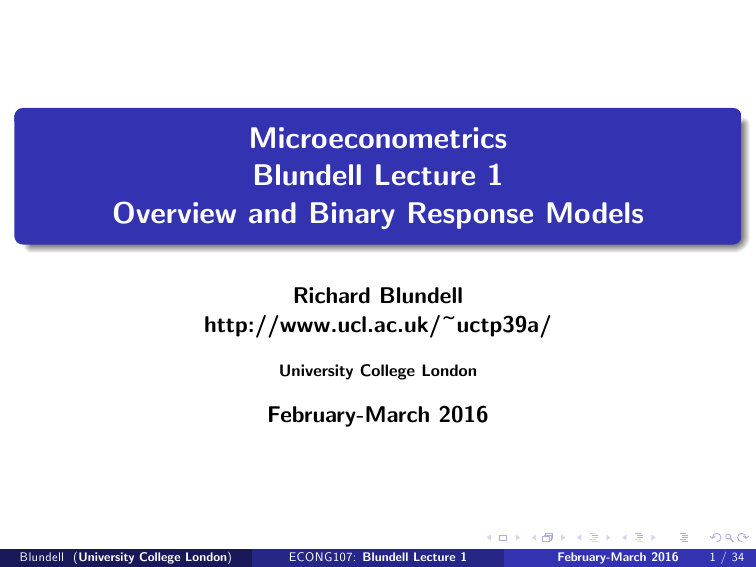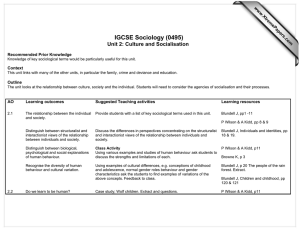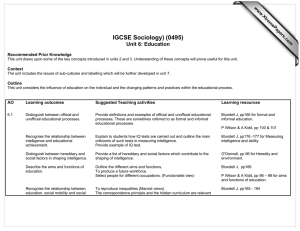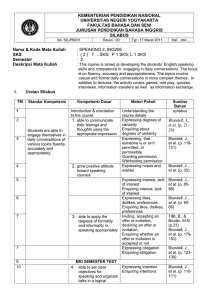Microeconometrics Blundell Lecture 1 Overview and Binary Response Models Richard Blundell
advertisement

Microeconometrics Blundell Lecture 1 Overview and Binary Response Models Richard Blundell http://www.ucl.ac.uk/~uctp39a/ University College London February-March 2016 Blundell (University College London) ECONG107: Blundell Lecture 1 February-March 2016 1 / 34 Overview Subtitle: Models, Sampling Designs and Non/Semiparametric Estimation 1 discrete data: binary response Blundell (University College London) ECONG107: Blundell Lecture 1 February-March 2016 2 / 34 Overview Subtitle: Models, Sampling Designs and Non/Semiparametric Estimation 1 discrete data: binary response 2 censored and truncated data : cenoring models Blundell (University College London) ECONG107: Blundell Lecture 1 February-March 2016 2 / 34 Overview Subtitle: Models, Sampling Designs and Non/Semiparametric Estimation 1 discrete data: binary response 2 censored and truncated data : cenoring models 3 endogenously selected samples: selectivity model Blundell (University College London) ECONG107: Blundell Lecture 1 February-March 2016 2 / 34 Overview Subtitle: Models, Sampling Designs and Non/Semiparametric Estimation 1 discrete data: binary response 2 censored and truncated data : cenoring models 3 endogenously selected samples: selectivity model 4 experimental and quasi-experimental data: evaluation methods Blundell (University College London) ECONG107: Blundell Lecture 1 February-March 2016 2 / 34 Overview Subtitle: Models, Sampling Designs and Non/Semiparametric Estimation 1 discrete data: binary response 2 censored and truncated data : cenoring models 3 endogenously selected samples: selectivity model 4 experimental and quasi-experimental data: evaluation methods social experiments methods Blundell (University College London) ECONG107: Blundell Lecture 1 February-March 2016 2 / 34 Overview Subtitle: Models, Sampling Designs and Non/Semiparametric Estimation 1 discrete data: binary response 2 censored and truncated data : cenoring models 3 endogenously selected samples: selectivity model 4 experimental and quasi-experimental data: evaluation methods social experiments methods natural experiment methods Blundell (University College London) ECONG107: Blundell Lecture 1 February-March 2016 2 / 34 Overview Subtitle: Models, Sampling Designs and Non/Semiparametric Estimation 1 discrete data: binary response 2 censored and truncated data : cenoring models 3 endogenously selected samples: selectivity model 4 experimental and quasi-experimental data: evaluation methods social experiments methods natural experiment methods matching methods Blundell (University College London) ECONG107: Blundell Lecture 1 February-March 2016 2 / 34 Overview Subtitle: Models, Sampling Designs and Non/Semiparametric Estimation 1 discrete data: binary response 2 censored and truncated data : cenoring models 3 endogenously selected samples: selectivity model 4 experimental and quasi-experimental data: evaluation methods social experiments methods natural experiment methods matching methods instrumental methods Blundell (University College London) ECONG107: Blundell Lecture 1 February-March 2016 2 / 34 Overview Subtitle: Models, Sampling Designs and Non/Semiparametric Estimation 1 discrete data: binary response 2 censored and truncated data : cenoring models 3 endogenously selected samples: selectivity model 4 experimental and quasi-experimental data: evaluation methods social experiments methods natural experiment methods matching methods instrumental methods regression discontinuity and regression kink methods Blundell (University College London) ECONG107: Blundell Lecture 1 February-March 2016 2 / 34 Overview Subtitle: Models, Sampling Designs and Non/Semiparametric Estimation 1 discrete data: binary response 2 censored and truncated data : cenoring models 3 endogenously selected samples: selectivity model 4 experimental and quasi-experimental data: evaluation methods social experiments methods natural experiment methods matching methods instrumental methods regression discontinuity and regression kink methods control function methods Blundell (University College London) ECONG107: Blundell Lecture 1 February-March 2016 2 / 34 6. Discrete Choice Binary Response Models Let yi = 1 if an action is taken (e.g. a person is employed) yi = 0 otherwise for an individual or a …rm i = 1, 2, ...., N. We will wish to model the probability that yi = 1 given a kx1 vector of explanatory characteristics xi0 = (x1i , x2i , ..., xki ). Write this conditional probability as: Pr[yi = 1jxi ] = F (xi0 β) Blundell (University College London) ECONG107: Blundell Lecture 1 February-March 2016 3 / 34 6. Discrete Choice Binary Response Models Let yi = 1 if an action is taken (e.g. a person is employed) yi = 0 otherwise for an individual or a …rm i = 1, 2, ...., N. We will wish to model the probability that yi = 1 given a kx1 vector of explanatory characteristics xi0 = (x1i , x2i , ..., xki ). Write this conditional probability as: Pr[yi = 1jxi ] = F (xi0 β) This is a single linear index speci…cation. Semi-parametric if F is unknown. We need to recover F and β to provide a complete guide to behaviour. Blundell (University College London) ECONG107: Blundell Lecture 1 February-March 2016 3 / 34 Binary Response Models We often write the response probability as p (x ) = Pr(y = 1jx ) = Pr(y = 1jx1 , x2 , ..., xk ) for various values of x. Blundell (University College London) ECONG107: Blundell Lecture 1 February-March 2016 4 / 34 Binary Response Models We often write the response probability as p (x ) = Pr(y = 1jx ) = Pr(y = 1jx1 , x2 , ..., xk ) for various values of x. Bernoulli (zero-one) Random Variables if Pr(y = 1jx ) = p (x ) then Pr(y = 0jx ) = 1 p (x ) E (y jx ) = p (x ) = 1.p (x ) + 0.(1 Var (y jx ) = p (x )(1 Blundell (University College London) p (x ) p (x )) ECONG107: Blundell Lecture 1 February-March 2016 4 / 34 Binary Response Models The Linear Probability Model Pr(y = 1jx ) = β0 + β1 x1 + ... + βk xk = β0 x Unless x is severely restricted, the LPM cannot be a coherent model of the response probability P (y = 1jx ), as this could lie outside zero-one. Note: E (y jx ) = β0 + β1 x1 + ... + βk xk Var (y jx ) = β0 x (1 x 0 β) which implies that the OLS estimator is unbiased but ine¢ cient. The ine¢ ciency due to the heteroskedasticity. Homework: Develop a two-step estimator. Blundell (University College London) ECONG107: Blundell Lecture 1 February-March 2016 5 / 34 Binary Response Models Typically express binary response models as a latent variable model: yi = xi0 β + ui where u is some continuously distributed random variable distributed independently of x, where we typically normalise the variance of u. I The observation rule for y is given by y = 1(y > 0). Pr[yi 0jxi ] () Pr[ui = 1 = 1 Pr[ui xi0 β] xi0 β] G ( xi0 β) where G is the cdf of ui . Blundell (University College London) ECONG107: Blundell Lecture 1 February-March 2016 6 / 34 Binary Response Models In the symmetric distribution case (Probit and Logit) Pr[yi 0jxi ] = G (xi0 β) where G is some (monotone increasing) cdf. (Make sure you can prove this). I This speci…cation is the linear single index model. I Show that for the linear utility and a normal unobserved heterogeneity implies the single index Probit model Blundell (University College London) ECONG107: Blundell Lecture 1 February-March 2016 7 / 34 Binary Response Models Random sample of observations on yi and xi i = 1, 2, ....N. Pr[yi = 1jxi ] = F (xi0 β) where F is some (monotone increasing) cdf. This is the linear single index model. Questions? I How do we …nd β given a choice of F (.) and a sample of observations on yi and xi ? I How do we check that the choice of F (.) is correct? I Do we have to choose a parametric form for F (.)? I Do we need a random sample - or can we estimate with good properties from (endogenously) strati…ed samples? I What if the data is not binary - ordered, count, multiple discrete choices? Blundell (University College London) ECONG107: Blundell Lecture 1 February-March 2016 8 / 34 ML Estimation of the Binary Choice Model Assume we have N independent observations on yi and xi . The probability density of yi conditional on xi is given by: F (xi0 β) if yi = 1, and 1 F (xi0 β) if yi = 0. Therefore the density of any yi can be written: f (yi jxi0 β) = F (xi0 β)yi (1 F (xi0 β))1 yi . The joint probability of this particular sequence of data is given by the product of these associated probabilities (under independence). Therefore the joint distribution of the particular sequence we observe in a sample of N observations is simply: 0 f (y1 , y2 , ...., yN ) = ∏N i =1 F xi β yi (1 F xi0 β )1 yi This depends on a particular β and is also the `likelihood 0 of the sequence y1 , y2 ..., yN , L( β; y1 , y2 , ...., yN ) = ∏Ni=1 F xi0 β Blundell (University College London) yi ECONG107: Blundell Lecture 1 (1 F xi0 β )1 yi February-March 2016 9 / 34 ML Estimation of the Binary Choice Model If the model is correctly speci…ed then the MLE b βN will be - consistent, e¢ cient and asymptotically normal. log L is an easier expression: N log L( β; y1 , y2 , ...., yN ) = ∑ [yi log F xi0 β + (1 yi ) log(1 F xi0 β ] i =1 I The derivative of log L with respect to β is given by: ∂ log L ∂β N = ∑ [yi i =1 N = yi yi ) f (xi0 β) xi ] 1 F (xi0 β) F (xi0 β) .f xi0 β .xi F (xi0 β)) ∑ F (x 0 β ) (1 i =1 Blundell (University College London) f (xi0 β) xi + (1 F (xi0 β) i ECONG107: Blundell Lecture 1 February-March 2016 10 / 34 ML Estimation of the Binary Choice Model The MLE b βN refers to any root of the likelihood equation that corresponds to a local maximum. ∂ log L ∂β jN =0 If log L is a concave function of β, as in the Probit and Logit cases ∂2 ln LN ( β) ), ∂β∂β0 (Exercise: prove for the Probit using N1 Otherwise there exists a consistent root. then this is unique. I We will consider the properties of the average log likelihood N1 log L, and assume that is converges to the ‘true’log likelihood and that this is maximised at the true value of β, given by β0 . L I Notice that ∂ log is nonlinear in β. In general, no explicit solution can ∂β be found. We have to use ‘iterative’procedures to …nd the maximum. Blundell (University College London) ECONG107: Blundell Lecture 1 February-March 2016 11 / 34 ML Estimation of the Binary Choice Model Iterative Algorithms: Choose an initial β(0 ) . Gradient method: L β(1 ) = β(0 ) + ∂ log ∂β j β(0 ) Convergence is slow De‡ected Gradient method: L β(1 ) = β(0 ) + H (0 ) ∂ log ∂β j β(0 ) H (0 ) = H (0 ) = H (0 ) = E 2 1 ∂ ln LN ( β) j β (0 ) N ∂β∂β0 E h ∂2 ln LN ( β) j β (0 ) ∂β∂β0 1 1 ∂ ln LN ( β) ∂ ln LN ( β) ∂β ∂β0 Blundell (University College London) i Newton Scoring Method j β (0 ) 1 BHHH Method ECONG107: Blundell Lecture 1 February-March 2016 12 / 34 ML Estimation of the Binary Choice Model Theorem 1. (Consistency). If (i) the true parameter value β0 is an interior point of parameter space. (ii) ln LN ( β) is continuous. (iii) there exists a neighbourhood of β0 such that N1 ln LN ( β) converges to a constant limit ln L( β) and that ln L( β) has a local maximum at β0 . Then the MLE b βN is consistent, or there exists a consistent root. I Note: 1 2 requires the correct speci…cation of ln LN ( β), in particular the Pr[yi = 1jxi ]. Contrast with MLE in the linear model. Blundell (University College London) ECONG107: Blundell Lecture 1 February-March 2016 13 / 34 ML Estimation of the Binary Choice Model Theorem 2. (Asymptotic Normality). If ∂2 ln L ( β) (i) ∂β∂βN 0 exists and is continuous 2 1 ∂ ln LN ( β) evaluated at b βN converges. N ∂β∂β0 ∂ ln LN ( β) 1 d N (0, H ) (iii) p 0 pN ∂β then N (b βN βN ) d N (0, H 1 ). (ii) where H = lim N !∞ I Note: E and h E N1 E 1 ∂2 ln LN ( β) j β0 . N ∂β∂β0 1 ∂2 ln LN ( β) 1 ∂ ln LN ( β) ∂ ln LN ( β) j β0 = E j β0 0 N N ∂β ∂β∂β ∂β0 ∂2 ln LN ( β) j βo ∂β∂β0 Blundell (University College London) i 1 is the Cramer-Rao lower bound. ECONG107: Blundell Lecture 1 February-March 2016 14 / 34 ML Estimation of the Binary Choice Model Note that for Probit (and Logit) estimators E ∂2 ln LN ( β) ∂β∂β0 N = [φ (xi0 β)]2 ∑ Φ (x 0 β) [1 Φ (x 0 β)] xi xi0 i i i =1 N = ∑ di xi xi0 i =1 = X 0 DX So that the var (b βN ) can be approximated by (X 0 DX ) 1 I This expression has a similar form to that in the heteroscedastic GLS model. Blundell (University College London) ECONG107: Blundell Lecture 1 February-March 2016 15 / 34 Binary Response Models The EM Algorithm In the case of the Probit there is another useful algorithm: yi = xi0 β + ui with ui N (0, 1) and yi = 1(yi > 0) now note that E ( yi j yi = 1) = xi0 β + E (ui jxi0 β + ui = xi0 β + E (ui jui xi0 β) φ(xi0 β) = xi0 β + Φ(xi0 β) similarly E (yi jyi = 0) = xi0 β Blundell (University College London) 0) φ(xi0 β) Φ(xi0 β) ECONG107: Blundell Lecture 1 February-March 2016 16 / 34 Binary Response Models The EM Algorithm If we now de…ne mi = E (yi jyi ) then the derivative of the log likelihood can be written N ∂ log L = ∑ xi (mi ∂β i =1 xi0 β) set this to zero (to solve for β) N N i =1 i =1 ∑ xi mi = ∑ xi xi0 β as in the OLS normal equations. We do not observe yi but mi is the best guess given the information we have. Blundell (University College London) ECONG107: Blundell Lecture 1 February-March 2016 17 / 34 Binary Response Models The EM Algorithm Solving for β we have b β= N ∑ i =1 xi xi0 ! 1 N ∑ xi mi . i =1 Notice mi depends on β. This forms an EM (or Fair) algorithm: I 1. Choose β(0) I 2. Form mi (0) and compute β(1), etc. I This converges, but slower than de‡ected gradient methods. Blundell (University College London) ECONG107: Blundell Lecture 1 February-March 2016 18 / 34 Binary Response Models Samples and Sampling Let Pr(y jx 0 β) be the population conditional probability of y given x. Let f (x ) be the true marginal distribution of x. Let π (y jx 0 β) be the sample conditional probability. I Case 1: Random Sampling π (y , x ) = π (y jx 0 β ) π (x ) but π (x ) = f (x ) and π (y jx 0 β) = Pr(y jx 0 β). I Case 2: Exogenous Strati…cation π (y , x ) = Pr(y jx 0 β)π (x ) Although π (x ) 6= f (x ) the sample still replicates the conditional probability of interest in the population which is the only term that contains β in the log likelihood. Blundell (University College London) ECONG107: Blundell Lecture 1 February-March 2016 19 / 34 Binary Response Models Samples and Sampling I Case 3: Choice Based Sampling (Manski and Lerman) Suppose Q is the population proportion that make choice y = 1. Let P represent the sample fraction. Then we can adjust the likelihood contribution by: Q F (xi0 β). P If we know Q then the adjusted MLE is consistent for choice-based samples. Blundell (University College London) ECONG107: Blundell Lecture 1 February-March 2016 20 / 34 Binary Response Models Semiparametric Estimation in the Linear Index Case I (i) Semiparametric E (yi jxi ) = F xi0 β retain …nite parameter vector β in the linear index but relax the parametric form for F . I (ii) Nonparametric E (yi jxi ) = F (g (xi )) both F and g are nonparametric. As you would expect, typically (i) has been followed in research. What is the parameter of interest? β alone? Notice that the function F (a + bxi0 β) cannot be separately identi…ed from F (xi0 β). Therefore β is only identi…ed up to location and scale. Blundell (University College London) ECONG107: Blundell Lecture 1 February-March 2016 21 / 34 Binary Response Models Semiparametric Estimation in the Linear Index Case To motivate, imagine xi0 β zi was known but F (.) was not. Seems obvious: run a general nonparametric (kernel say) regression of y on z. I (i) How do we …nd β? I (ii) How do we guarantee monotonic increasing F ? Blundell (University College London) ECONG107: Blundell Lecture 1 February-March 2016 22 / 34 Binary Response Models Semiparametric Estimation in the Linear Index Case Semiparametric Estimation of β (single index models) * Iterated Least Squares and Quasi-Likelihood Estimation (Ichimura and Klein/Spady) Note that E (yi jxi ) = F xi0 β so that yi = F xi0 β + εi with E (εi jxi ) = 0. A semiparametric least squares estimator can be derived. Choose β to minimise 1 S ( β) = ∑ π (xi )(yi F (xi0 β))2 N replacing F with a kernel regression Fh at each step with bandwidth h, simply a function of the scaler xi0 β for some given value of β. π (xi ) is a trimming function that downweights observations near the boundary of the support of xi0 β. Blundell (University College London) ECONG107: Blundell Lecture 1 February-March 2016 23 / 34 Binary Response Models Semiparametric Estimation in the Linear Index Case Typically Fh is estimated using a leave-one-out kernel. Blundell (University College London) ECONG107: Blundell Lecture 1 February-March 2016 24 / 34 Binary Response Models Semiparametric Estimation in the Linear Index Case Typically Fh is estimated using a leave-one-out kernel. Ichimura (1993) shows that this estimator of β up to scale is p N consistent and asymptotically normal. Blundell (University College London) ECONG107: Blundell Lecture 1 February-March 2016 24 / 34 Binary Response Models Semiparametric Estimation in the Linear Index Case Typically Fh is estimated using a leave-one-out kernel. Ichimura (1993) shows that this estimator of β up to scale is p N consistent and asymptotically normal. We have to assume F is di¤erentiable and requires at least one continuous regressor with a non-zero coe¢ cient. Blundell (University College London) ECONG107: Blundell Lecture 1 February-March 2016 24 / 34 Binary Response Models Semiparametric Estimation in the Linear Index Case Typically Fh is estimated using a leave-one-out kernel. Ichimura (1993) shows that this estimator of β up to scale is p N consistent and asymptotically normal. We have to assume F is di¤erentiable and requires at least one continuous regressor with a non-zero coe¢ cient. I Extends naturally to some other semi-parametric least squares cases. Blundell (University College London) ECONG107: Blundell Lecture 1 February-March 2016 24 / 34 Binary Response Models Semiparametric Estimation in the Linear Index Case Typically Fh is estimated using a leave-one-out kernel. Ichimura (1993) shows that this estimator of β up to scale is p N consistent and asymptotically normal. We have to assume F is di¤erentiable and requires at least one continuous regressor with a non-zero coe¢ cient. I Extends naturally to some other semi-parametric least squares cases. I It is also common to weight the elements in this regression to allow for heteroskedasticity. Blundell (University College London) ECONG107: Blundell Lecture 1 February-March 2016 24 / 34 Binary Response Models Semiparametric Estimation in the Linear Index Case Note that the average log-likelihood can be written: 1 1 log LN ( β) = N N ∑ π (xi )fyi ln F (xi0 β) + (1 yi )yi ln(1 F (xi0 β)) So maximise log LN ( β), replacing F (.) by kernel type non-parametric regression of y on zi = xi0 β at each step. I Klein and Spady (1993) show asymptotic normality and that the outer-product of the gradients of the quasi-loglikelihood is a consistent estimator of the variance-covariance matrix. Blundell (University College London) ECONG107: Blundell Lecture 1 February-March 2016 25 / 34 Binary Response Models Semiparametric Estimation in the Linear Index Case Maximum Score Estimation (Manski) Suppose F is unknown Assume: the conditional median of u given x is zero (note that this is weaker than independence between u and x ) =) 1 Pr[yi = 1jxi ] > ( ) if xi0 β > ( )0 2 I Maximum Score Algorithm: score 1 if yi = 1 and xi0 β > 0, or yi = 0 and xi0 β 0. score 0 otherwise. Choose b β that maximises the score, subject to some normalisation on β. Blundell (University College London) ECONG107: Blundell Lecture 1 February-March 2016 26 / 34 Binary Response Models Semiparametric Estimation in the Linear Index Case Note that the scoring algorithm can be written: choose β to maximise SN ( β ) = 1 N N ∑ [2.1(yi = 1) 1]1(xi0 β 0). i =1 The complexity of the estimator is due to the discontinuity of the function SN ( β ) . Horowitz (1992) suggests a smoothed MSE: SN ( β ) = 1 N N ∑ [2.1(yi = 1) i =1 1]K ( xi0 β ) h where K is some continuous kernel function with p bandwidth h. I No longer discontinuous. Therefore can prove N convergence and asymptotic distribution properties. Blundell (University College London) ECONG107: Blundell Lecture 1 February-March 2016 27 / 34 Binary Response Models Endogenous Variables Consider the following (triangular) model y1i y2i = x1i0 β + γy2i + u1i = zi0 π 2 + v2i (1) (2) where y1i = 1(y1i > 0). zi0 = (x1i0 , x2i0 ). The x2i0 are the excluded ‘instruments’from the equation for y1 . The …rst equation is a the ‘structural’equation of interest and the second equation is the ‘reduced form’for y2 . I y2 is endogenous if u1 and v2 are correlated. If y1 was fully observed we could use IV (or 2SLS). Blundell (University College London) ECONG107: Blundell Lecture 1 February-March 2016 28 / 34 Binary Response Models Control Function Approach Use the following othogonal decomposition for u1 u1i = ρv2i + e1i where E (e1i jv2i ) = 0. I Note that y2 is uncorrelated with u1i conditional on v2 . The variable v2 is sometimes known as a control function. I Under the assumption that u1 and v2 are jointly normally distributed, u2 and e are uncorrelated by de…nition and e also follows a normal distribution. Blundell (University College London) ECONG107: Blundell Lecture 1 February-March 2016 29 / 34 Binary Response Models Control Function Estimator Use this to de…ne the augmented model y1i y2i = x1i0 β + γy2i + ρv2i + e1i = zi0 π 2 + v2i 2-step Estimator: I Step 1: Estimate π 2 by OLS and predict v2 , vb2i = y2i b 20 zi π I Step 2: use vb2i as a ‘control function’in the model for y1 above and estimate by standard methods. Blundell (University College London) ECONG107: Blundell Lecture 1 February-March 2016 30 / 34 Binary Response Models Semi-parametric Estimation with Endogeneity I Blundell and Powell (REStud, 2004) extend the control function approach to the semiparametric case. I Suppose we de…ne xi0 = [x1i0 , y2i ] and β00 = [ β0 , γ]. Recall that if x is independent of u1, then E (y1i j xi ) = G (xi0 β0 ) where G is the distribution function for u1 . Sometimes also known as the average structural function, ASF. I Note that with endogeneity of u1 we can invoke the control function assumption: u1 ? x j v2 I This is the conditional independence assumption derived from the triangularity assumption in the simultaneous equations model, see Blundell and Matzkin (2013). Blundell (University College London) ECONG107: Blundell Lecture 1 February-March 2016 31 / 34 Binary Response Models Semi-parametric Estimation with Endogeneity I Using the control function assumption we have E [y1i jxi , v2i ] = F (xi0 β0 , v2i ), and G (xi0 β0 ) = Z F (xi0 β0 , v2i )dFv2 . I Blundell and Z Powell (2003) show β0 and the average structural function 0 G (xi β0 ) = F (xi0 β0 , v2i )dFv2 are point identi…ed. Blundell (University College London) ECONG107: Blundell Lecture 1 February-March 2016 32 / 34 Binary Response Models Semi-parametric Estimation with Endogeneity I Blundell and Powell (2004) develop a three step control function estimator: 1. Generate vb2 and run a nonparametric regression of y1i on xi and vb2i . B This provides a consistent nonparametric estimator of E [y1i jxi , v2i ]. 2. Impose the linear index assumption on xi0 β0 in: E [y1i jxi , v2i ] = F (xi0 β0 , v2i ). B This generates Fb (xi0 b β0 , vb2i ). 3. Integrate over the empirical distribution of vb2 to estimate b β0 and the 0 b b average structural function (ASF), G (xi β0 ). B This third step is implemented by taking the partial mean over vb2 in Fb (xi0 b β0 , vb2i ). Blundell (University College London) ECONG107: Blundell Lecture 1 February-March 2016 33 / 34 Binary Response Models Semi-parametric Estimation with Endogeneity I Able to show rate on ASF. p n consistency for b β0 , and the usual non-parametric I Blundell and Matzkin (2013) discuss the ASF and alternative parameters of interest. I Chesher and Rosen (2013) develop a new IV estimator in the binary choice and binary endogenous set-up. Blundell (University College London) ECONG107: Blundell Lecture 1 February-March 2016 34 / 34






